The Interrelations between a Multi-Layered Coastal Aquifer, a Surface Reservoir (Fish Ponds), and the Sea
Abstract
1. Introduction
2. Hydrogeological Background of the Study Area
3. Field Methods
4. Field Results
4.1. Water Level
4.2. EC Profiles
4.3. Electrical Resistivity—TDEM
4.4. Seismic Reflection
4.5. Radon
4.6. Hydrological Tests
5. Numerical Modeling
5.1. Geological Configuration
5.2. Hydraulic Properties
5.3. Boundary and Initial Conditions
5.4. Pumping Regime
5.5. Calibration of the Model
6. Simulation Results
6.1. Seawater Intrusion
6.2. Water Balance and Levels in Units B and C
6.3. Flow in Unit A
6.4. Tidal Effects
7. Discussion
7.1. Offshore Extension of the Confining Layer and Seawater Intrusion
7.2. The Impact of Pumping on the Adjacent Aquifer
7.3. Discharge to the Sea
8. Summary and Conclusions
- (1)
- The location of the hydraulic connection between a confined sub-aquifer and the sea (the distance from the shoreline) is shown to be a very important factor in the determination of the extent of seawater intrusion.
- (2)
- The location of the aquifer-sea connection also affects the tidal fluctuations in the monitoring boreholes.
- (3)
- Submarine CHIRP mapping indicates that the continuity of the confining clay varies on short spatial scales (2 km).
- (4)
- In the Numerical model, this difference in clay continuity resulted in different extent of seawater intrusion in the shallow confined layer.
- (5)
- Numerical simulations indicate that water level, as well as seawater intrusion in coastal aquifers, could be highly affected by its connection with an underlying aquifer.
Supplementary Materials
Author Contributions
Funding
Acknowledgments
Conflicts of Interest
References
- Bear, J.; Cheng, A.H.D.; Sorek, S.; Ouazar, D.; Herrera, I. (Eds.) Seawater Intrusion in Coastal Aquifers: Concepts, Methods, and Practices; Kluwer Academic Publishers: Dordrecht, The Netherlands; Boston, MA, USA; London, UK, 1999. [Google Scholar]
- Post, V. Fresh and saline groundwater interaction in coastal aquifers: Is our technology ready for the problems ahead? Hydrogeol. J. 2005, 13, 120–123. [Google Scholar] [CrossRef]
- Winter, T.C. Numerical simulation of steady state three-dimensional groundwater flow. Water Resour. Res. 1978, 14, 245–254. [Google Scholar] [CrossRef]
- Moore, W.S. Large groundwater inputs to coastal waters revealed by 226Ra enrichments. Nature 1996, 380, 612–614. [Google Scholar] [CrossRef]
- Weinstein, Y.; Burnett, W.C.; Swarzenski, P.W.; Shalem, Y.; Yechieli, Y.; Herut, B. The role of coastal aquifer heterogeneity in determining fresh groundwater discharge and seawater recycling: An example from the Carmel coast, Israel. J. Geophys. Res. 2007, 112, C12016. [Google Scholar] [CrossRef]
- Moore, W.S. The subterranean estuary: A reaction zone of ground water and sea water. Mar. Chem. 1999, 65, 111–125. [Google Scholar] [CrossRef]
- Woessner, W.W. Stream and fluvial plain ground water interactions: Rescaling hydrogeologic thought. Ground Water 2000, 38, 423–429. [Google Scholar] [CrossRef]
- Linderfelt, W.R.; Turner, J.V. Interaction between shallow groundwater, saline surface water and nutrient discharge in a seasonal estuary: The Swan–Canning system. Hydrol. Process. 2001, 15, 2631–2653. [Google Scholar] [CrossRef]
- Trefry, M.G.; Svensson, T.J.A.; Davis, G.B. Hypoaigic influences on groundwater flux to a seasonally saline river. J. Hydrol. 2007, 335, 330–353. [Google Scholar] [CrossRef]
- Herbeck, S.L.; Unger, D.; Wu, Y.; Jennerjahn, C.T. Effluent, nutrient and organic matter export from shrimp and fish ponds causing eutrophication in coastal and back-reef waters of NE Hainan, tropical China. Cont. Shelf Res. 2013, 57, 92–104. [Google Scholar] [CrossRef]
- Burford, M.A.; Costanzo, S.D.; Dennison, W.C.; Jackson, C.J.; Jones, A.B.; McKinnon, A.D.; Preston, N.P.; Trott, L.A. A synthesis of dominant ecological processes in intensive shrimp ponds and adjacent coastal environments in NE Australia. Mar. Pollut. Bull. 2003, 46, 1456–1469. [Google Scholar] [CrossRef]
- Tal, A.; Weinstein, Y.; Yechieli, Y.; Borisover, M. The influence of fish ponds and salinization on groundwater quality in the multi-layer coastal aquifer system in Israel. J. Hydrol. 2017, 551, 768–783. [Google Scholar] [CrossRef]
- Werner, A.D.; Bakker, M.; Post, V.A.; Vandenbohede, A.; Lu, C.; Ataie-Ashtiani, B.; Simmons, C.T.; Barry, D.A. Seawater intrusion processes, investigation and management: Recent advances and future challenges. Adv. Water Resour. 2013, 51, 3–26. [Google Scholar] [CrossRef]
- Boufadel, M.C. A mechanistic study of nonlinear solute transport in a groundwater-surface water system under steady state and transient hydraulic conditions. Water Resour. Res. 2000, 36, 2549–2565. [Google Scholar] [CrossRef]
- Mercer, J.W.; Larson, S.P.; Faust, C.R. Simulation of salt-water interface motion. Groundwater 1980, 18, 374–385. [Google Scholar] [CrossRef]
- Polo, J.F.; Ramis, F. Simulation of salt water–fresh water motion. Water Resour. Res. 1993, 19, 61–68. [Google Scholar] [CrossRef]
- Essaid, H.I. A multilayered sharp interface model of coupled freshwater and saltwater flow in coastal systems: Model development and application. Water Resour. Res. 1990, 26, 1431–1454. [Google Scholar] [CrossRef]
- Huyakorn, P.S.; Andersen, P.F.; Mercer, J.W.; White, H.O. Saltwater intrusion in quifers: Development and testing of a three-dimensional finite element model. Water Resour. Res. 1987, 23, 293–312. [Google Scholar] [CrossRef]
- Das, A.; Datta, B. Simulation of density dependent 2-D seawater intrusion in coastal aquifers using nonlinear optimization algorithm. In Proceedings of the American Water Resource Association of Annual Summer Symposium on Water Resource and Environmental Emphasis on Hydrology and Cultural Insight in Pacific Rim, Herndon, VA, USA, 1995; American Water Association: Herndon, VA, USA, 1995; pp. 277–286. [Google Scholar]
- Putti, M.; Paniconi, C. Finite element modeling of saltwater intrusion problems. In Advanced Methods for Groundwater Pollution Control; International Centre for Mechanical Sciences; Springer: New York, NY, USA, 1995; Volume 364, pp. 65–84. [Google Scholar]
- Guo, W.; Langevin, C. User’s guide to SEAWAT: A computer program for simulation of three-dimensional variable density groundwater flow. In Techniques of Water-Resources Investigations Book 6; US Geological Survey Intrusion of the Gaza Strip Aquifer—Palestine: Alicante, Spain, 2002; Volume 1, pp. 245–254. [Google Scholar]
- Yechiely, Y.; Shalev, E.; Wollman, S.; Kiro, Y.; Kafri, U. Response of the Mediterranean and Dead Sea coastal aquifers to sea level variations. Water Resour. Res. 2010, 46, W12550. [Google Scholar] [CrossRef]
- Van der Kamp, G. Tidal fluctuations in a confined aquifer extending under the sea. Int. Geol. Cong. 1972, 24, 101–106. [Google Scholar]
- Li, G.; Chen, C. Determining the length of confined aquifer roof extending under the sea by the tidal method. J. Hydrol. 1991, 123, 97–104. [Google Scholar]
- Li, G.; Chen, C. The determination of the boundary of confined aquifer extending under the sea by analysis of groundwater level fluctuations. Earth Sci. 1991, 16, 581–589. [Google Scholar]
- Li, H.; Jiao, J.J. Tide-induced groundwater fluctuation in a coastal leaky confined aquifer system extending under the sea. Water Resour. Res. 2001, 37, 1165–1171. [Google Scholar] [CrossRef]
- Burnett, W.C.; Kim, G.; Lane-Smith, D. A continuous monitor for assessment of 222Rn in the coastal ocean. J. Radioanal. Nucl. Chem. 2001, 249, 167–172. [Google Scholar]
- Conant, B., Jr. Delineating and quantifying ground water discharge zones using streambed temperatures. Ground Water 2004, 42, 243–257. [Google Scholar] [CrossRef] [PubMed]
- Mulligan, A.E.; Charette, M.A. Intercomparison of submarine groundwater discharge estimates from a sandy unconfined aquifer. J. Hydrol. 2006, 327, 411–425. [Google Scholar] [CrossRef]
- Li, L.; Barry, D.A.; Stagnitti, F.; Parlange, J.-Y. Submarine groundwater discharge and associated chemical input to a coastal sea. Water Resour. Res. 1999, 35, 3253–3259. [Google Scholar] [CrossRef]
- Li, H.; Jiao, J.J. Tide-induced seawater-groundwater circulation in a multi-layered coastal leaky aquifer system. J. Hydrol. 2003, 274, 211–224. [Google Scholar] [CrossRef]
- Swarzenski, P.W.; Burnett, W.C.; Greenwood, W.J.; Herut, B.; Peterson, R.; Dimova, N.; Shalem, Y.; Yechieli, Y.; Weinstein, Y. Combined time-series resistivity and geochemical tracer techniques to examine submarine groundwater discharge at Dor Beach Israel. Geophys. Res. Lett. 2006, 33, L24405. [Google Scholar] [CrossRef]
- Burnett, W.C.; Dulaiova, H. Estimating the dynamics of groundwater input into the coastal zone via continuous radon-222 measurements. J. Environ. Radioact. 2003, 69, 21–35. [Google Scholar] [CrossRef]
- Weinstein, Y.; Shalem, Y.; Burnett, W.C.; Swarzenski, P.W.; Herut, B. Temporal variability of Submarine Groundwater Discharge: Assessments via radon and seep meters, the southern Carmel Coast, Israel. In A New Focus on Groundwater–Seawater Interactions; Sanford, W., Ed.; IAHS Press: Wallingford, UK, 2007; Volume 312, pp. 125–133. [Google Scholar]
- Bar Yosef, J. Investigation of Salinization Mechanism in the Taninim Springs. Tahal Water Plan. Israel Tel Aviv Rep. 1974, 36. (In Hebrew) [Google Scholar]
- Bar, Y. Hydrogeology and Geochemistry of Groundwater in the Benyamina-Um El Fahm area. Master’s Thesis, The Hebrew University, Jerusalem, Israel, 1983. (In Hebrew with English Abstract). [Google Scholar]
- Dafny, E. Groundwater Flow and Solute Transport within the Yarqon-Taninim Aquifer, Israel. Ph.D. Thesis, The Hebrew University of Jerusalem, Jerusalem, Israel, 2009. (In Hebrew with English Abstract). [Google Scholar]
- Michelson, H.; Zeitoun, D.G. Desalinization in the Nahal Taninim Area. Tahal Water Plan. Israel Tel Aviv Rep. 1994, 73. (In Hebrew) [Google Scholar]
- Guttman, J. Defining Flow Systems and Groundwater Interactions in the Multi Aquifer System of the Carmel Coast Region. Ph.D. Thesis, Tel Aviv University, Tel Aviv, Israel, 1998. Mekorot Report No. 467. 90p. [Google Scholar]
- Bar-Yosef, Y.; Michaeli, A. Hydrological Situation in the Carmel Coastal Plain, Israel; NRD Report; NRD—NR/507/06; NRD: Tel Aviv, Israel, 2006. (In Hebrew) [Google Scholar]
- Michelson, C. Carmel Coast Geology; Tahal Report HG/70/025; Tahal: Tel Aviv, Israel, 1970. (In Hebrew) [Google Scholar]
- Almagor, G. The Mediterranean Coast of Israel, 2nd ed.; Geological Survey of Israel: Jerusalem, Israel, 2005; 273p. [Google Scholar]
- Tal, A.; Zilberbrand, M. Water Sources for the Coastal Aquifer in Maagan Michael Area; Inside Report; Hydrological Service of Israel: Jerusalem, Israel, 2010. [Google Scholar]
- Gilad, D.; Malul, A.; Goldman, M.; Ronen, A. Seawater Intrusion Mapping in the Coastal Plain, Israel, in the TDEM Method; HIS Report 1990/489/132/843; HIS: Tel Aviv, Israel, 1990. (In Hebrew) [Google Scholar]
- Goldman, M.; Gilad, D.; Ronen, A.; Melloul, A. Mapping of seawater intrusion into the coastal aquifer of Israel by the time domain electromagnetic method. Geoexploration 1991, 28, 153–174. [Google Scholar] [CrossRef]
- Goldman, M.; Rabinovich, B.; Rabinovich, M.; Gilad, D.; Gev, I.; Schirav, M. Application of the integrated NMR-TDEM method in groundwater exploration in Israel. J. Appl. Geophys. 1994, 31, 27–52. [Google Scholar] [CrossRef]
- Kafri, U.; Goldman, M.; Lang, B. Detection of subsurface brines, freshwater bodies and the interface configuration in between by the Time Domain electromagnetic (TDEM) method in the Dead Sea rift, Israel. J. Environ. Geol. 1997, 31, 42–49. [Google Scholar] [CrossRef]
- Golan, A. Shallow Geological Structure in the Sea Part of Maagan Michael Area; IOLR report H50/2014; IOLR: Tel Aviv, Israel, 2014. (In Hebrew) [Google Scholar]
- Lutski, H.; Shalev, E. Slug Test for Hydraulic Conductivity and Technical Status Interpretation of Wells in the Coastal Plain, Israel; GSI Report; GSI: Tel Aviv, Israel, 2010. (In Hebrew) [Google Scholar]
- Ward, R.S.; Williams, A.T.; Barker, J.A.; Brewerton, L.J.; Gale, I.N. Groundwater Tracer Test: A Review and Guidelines for Their Use in British Aquifers; British Geological Survey: Nottingham, UK, 1998; p. 286. [Google Scholar]
- Cooper, H.H.; Jacob, C.E. A generalized graphical method for evaluating formation constants and summarizing well field history. Am. Geophys. Union Trans. 1946, 27, 526–534. [Google Scholar] [CrossRef]
- Guttman, Y.; Cronveter, L. The Effect of Increasing Pumping on the Flow Regime in Maagan Michael—Zichron Yaakov Area; Mekorot Report No. 1291; Mekorot: Tel Aviv, Israel, 2007. (In Hebrew) [Google Scholar]
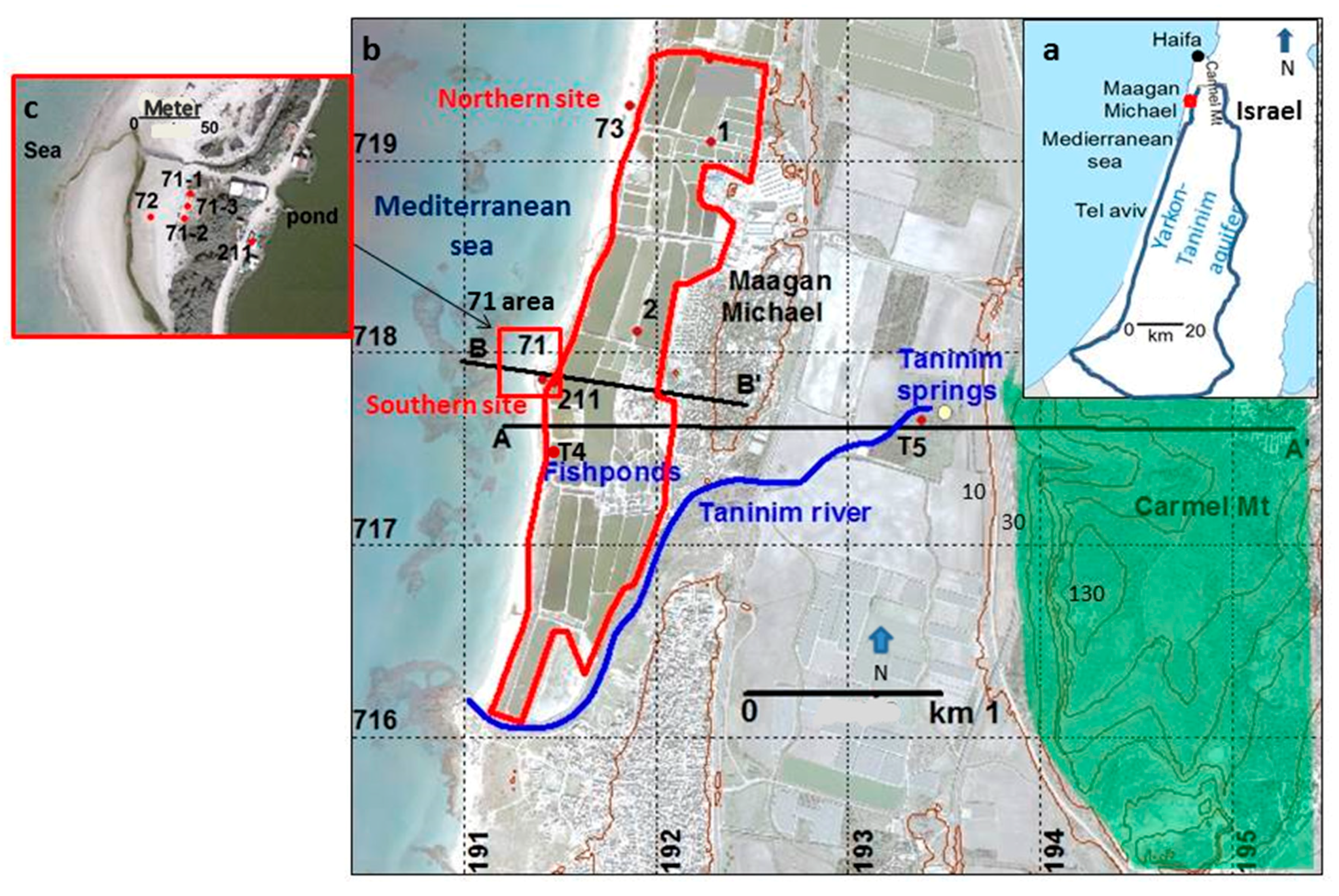
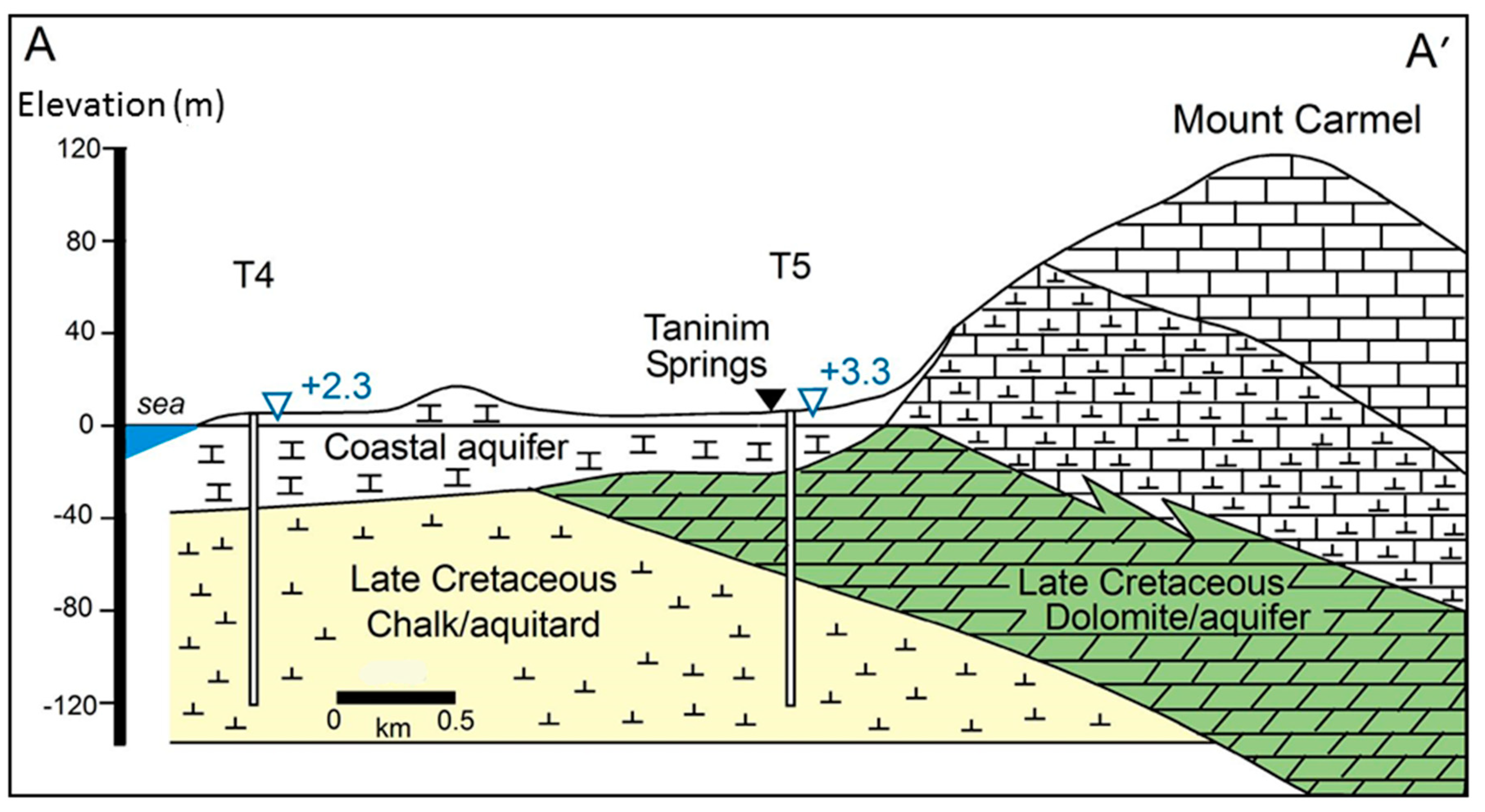
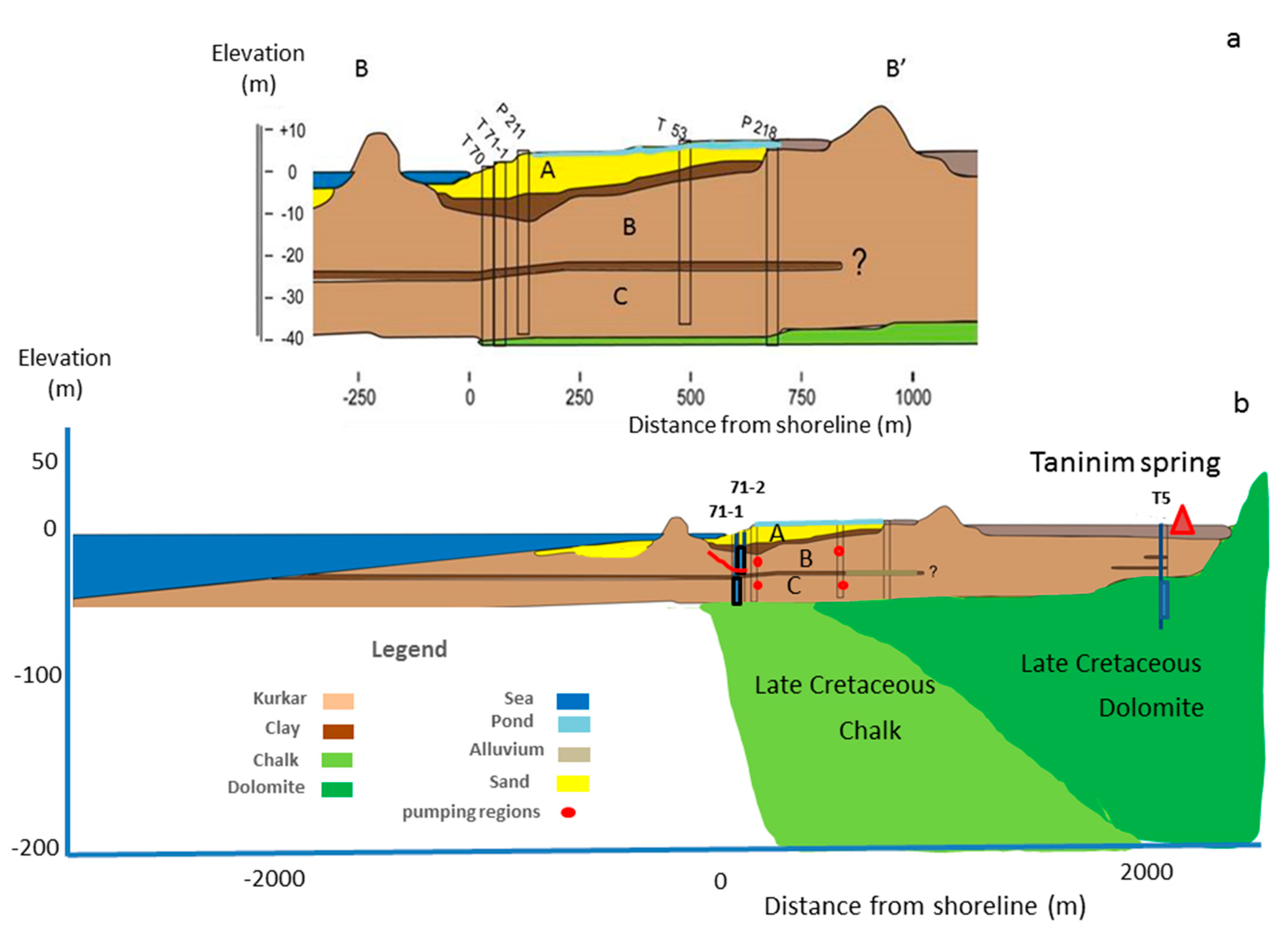
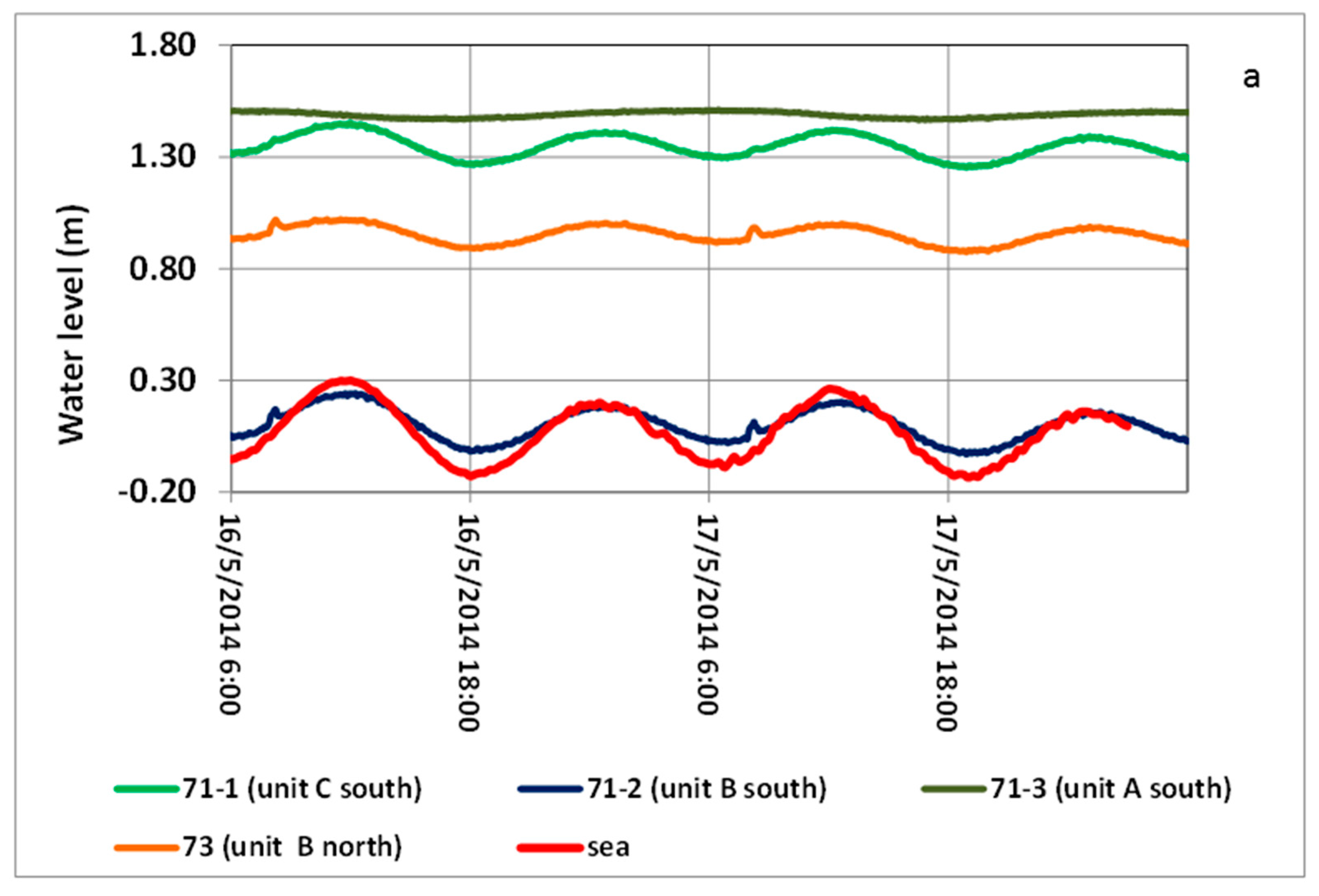
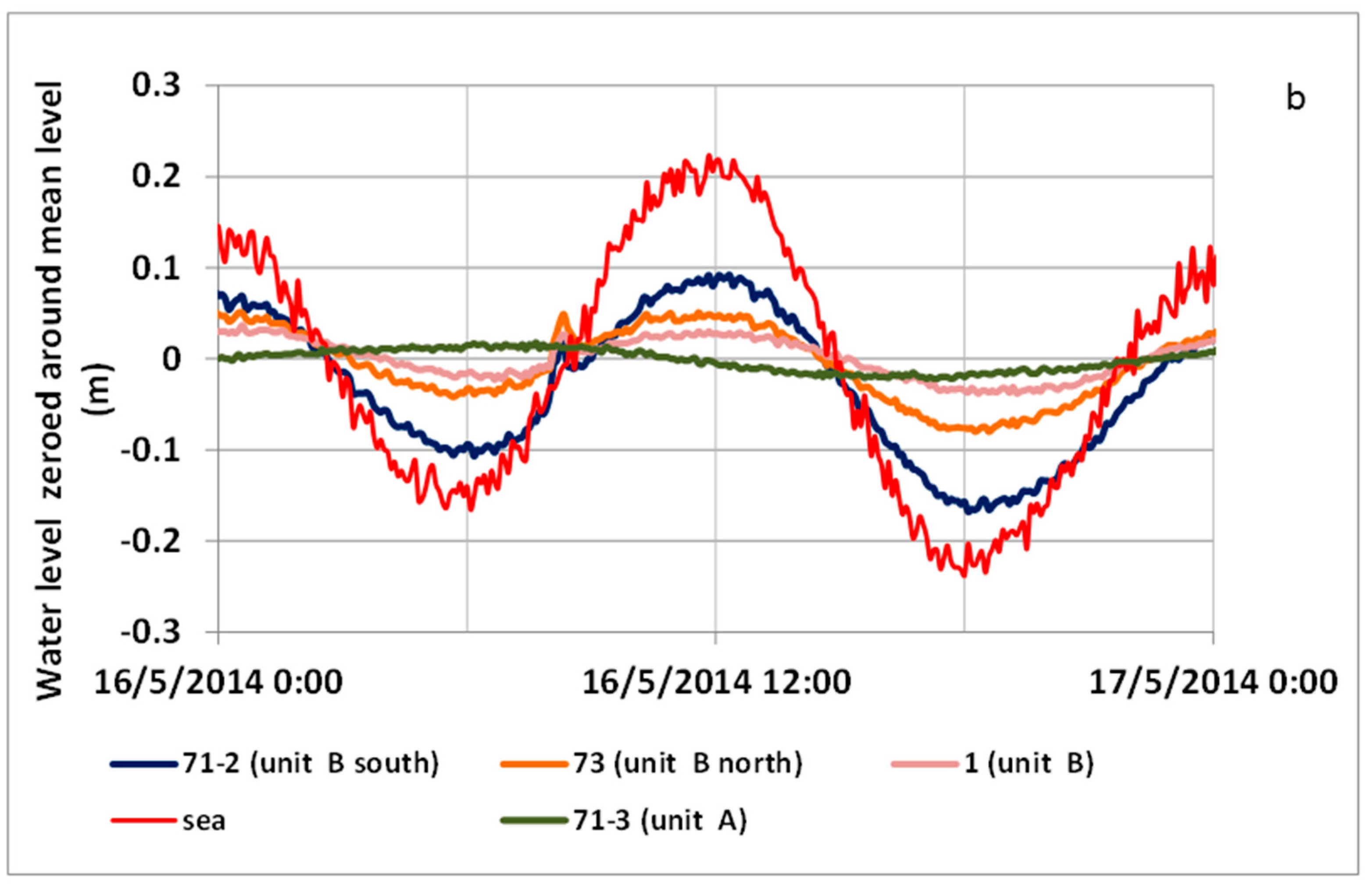
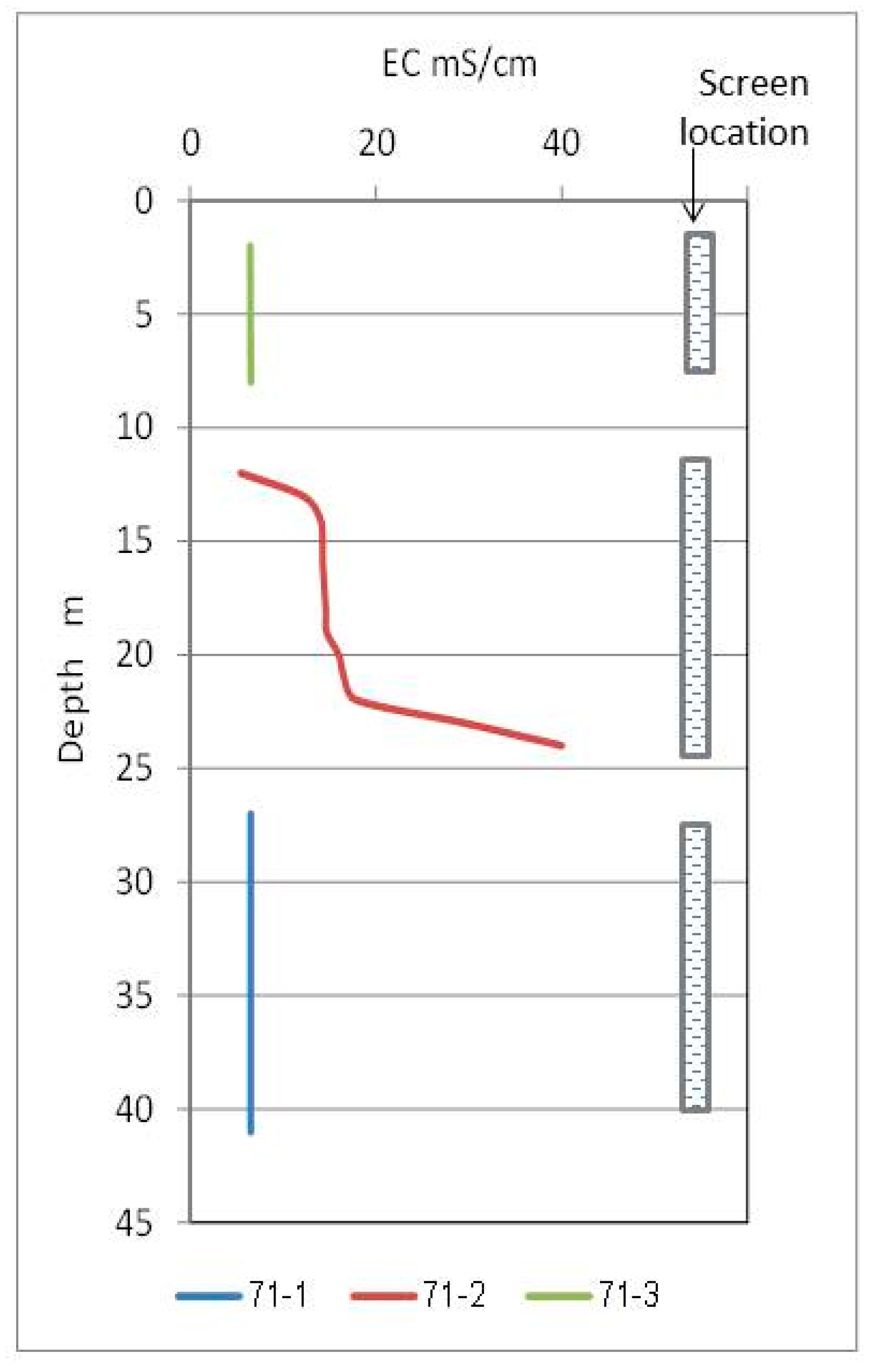
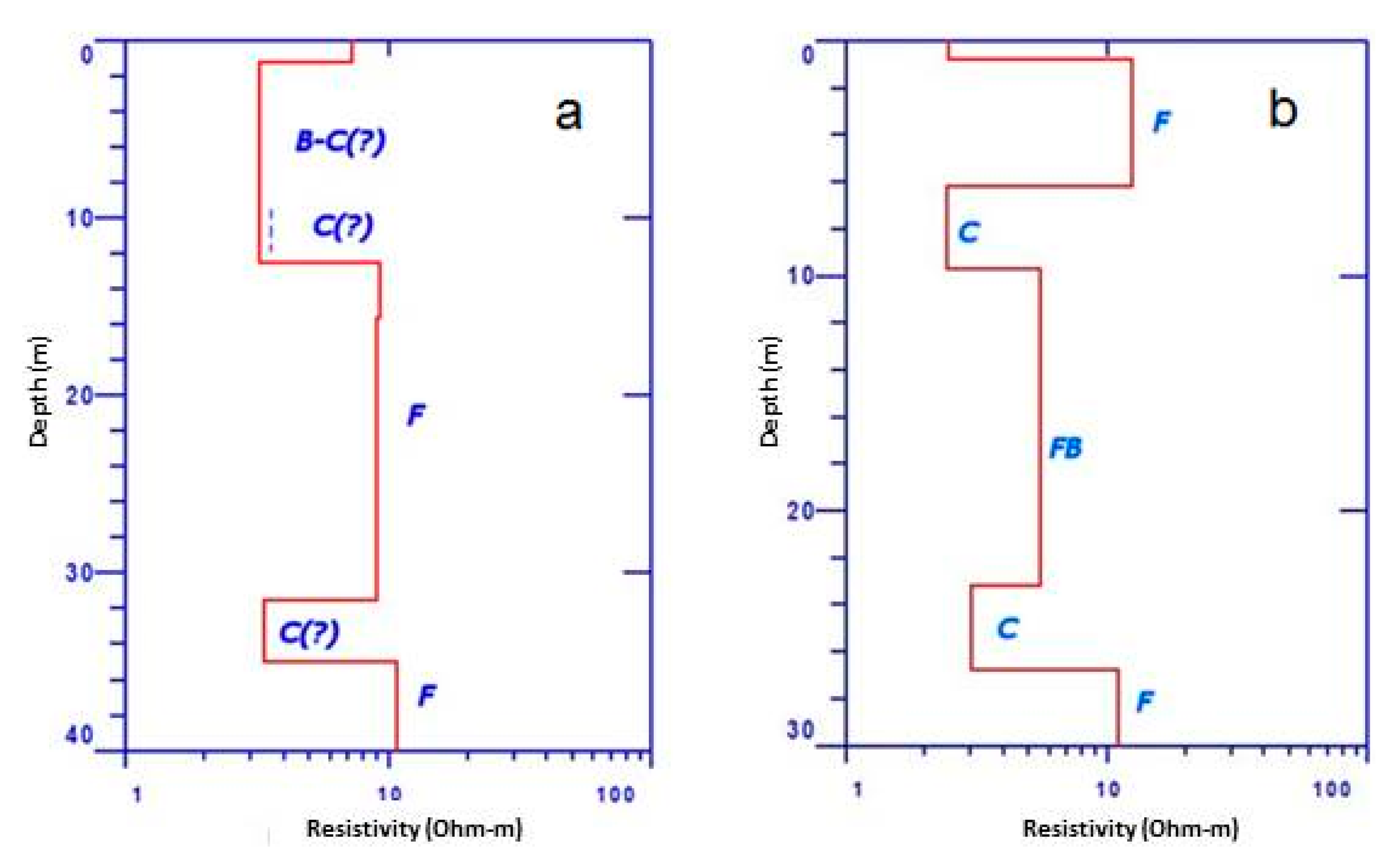
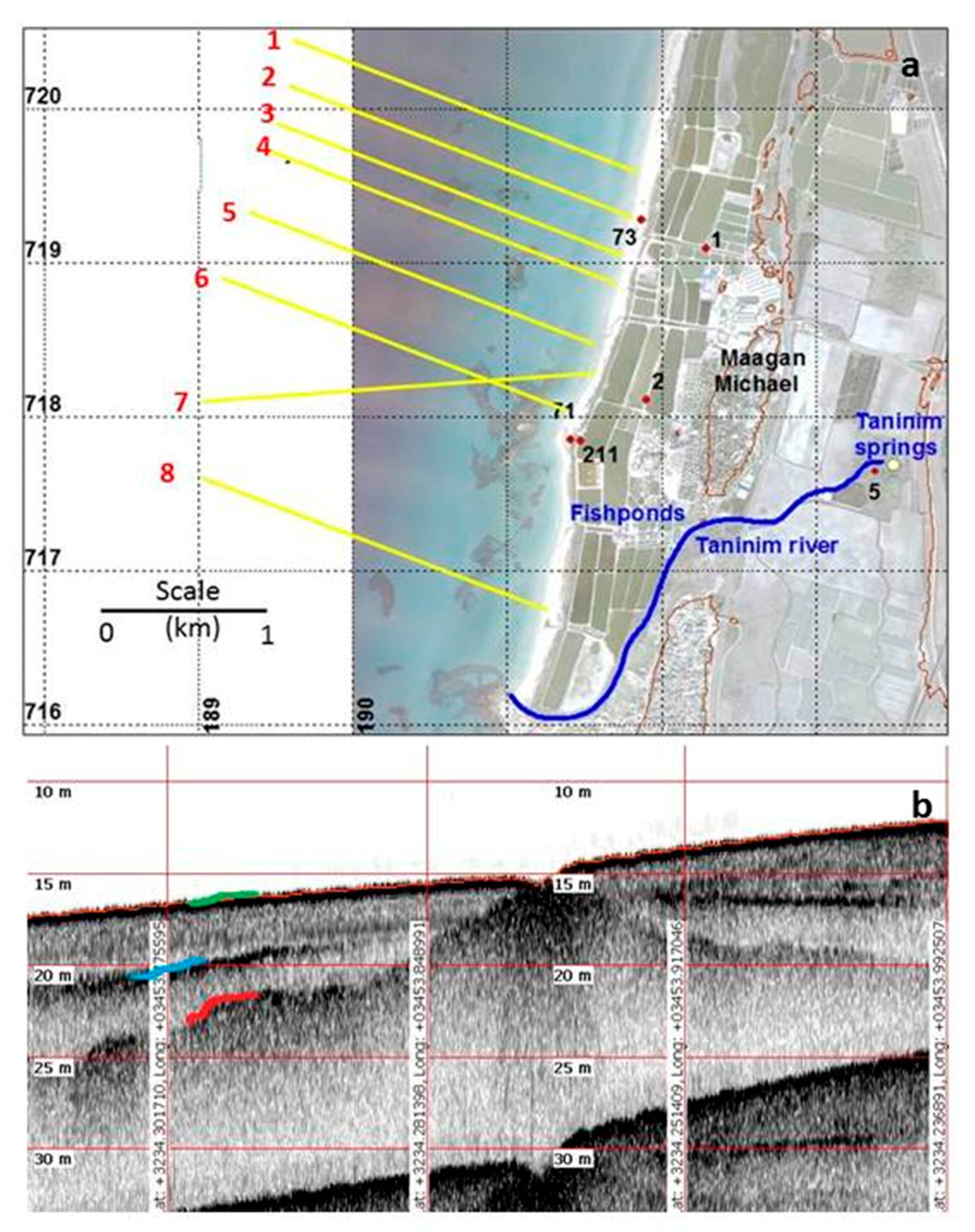
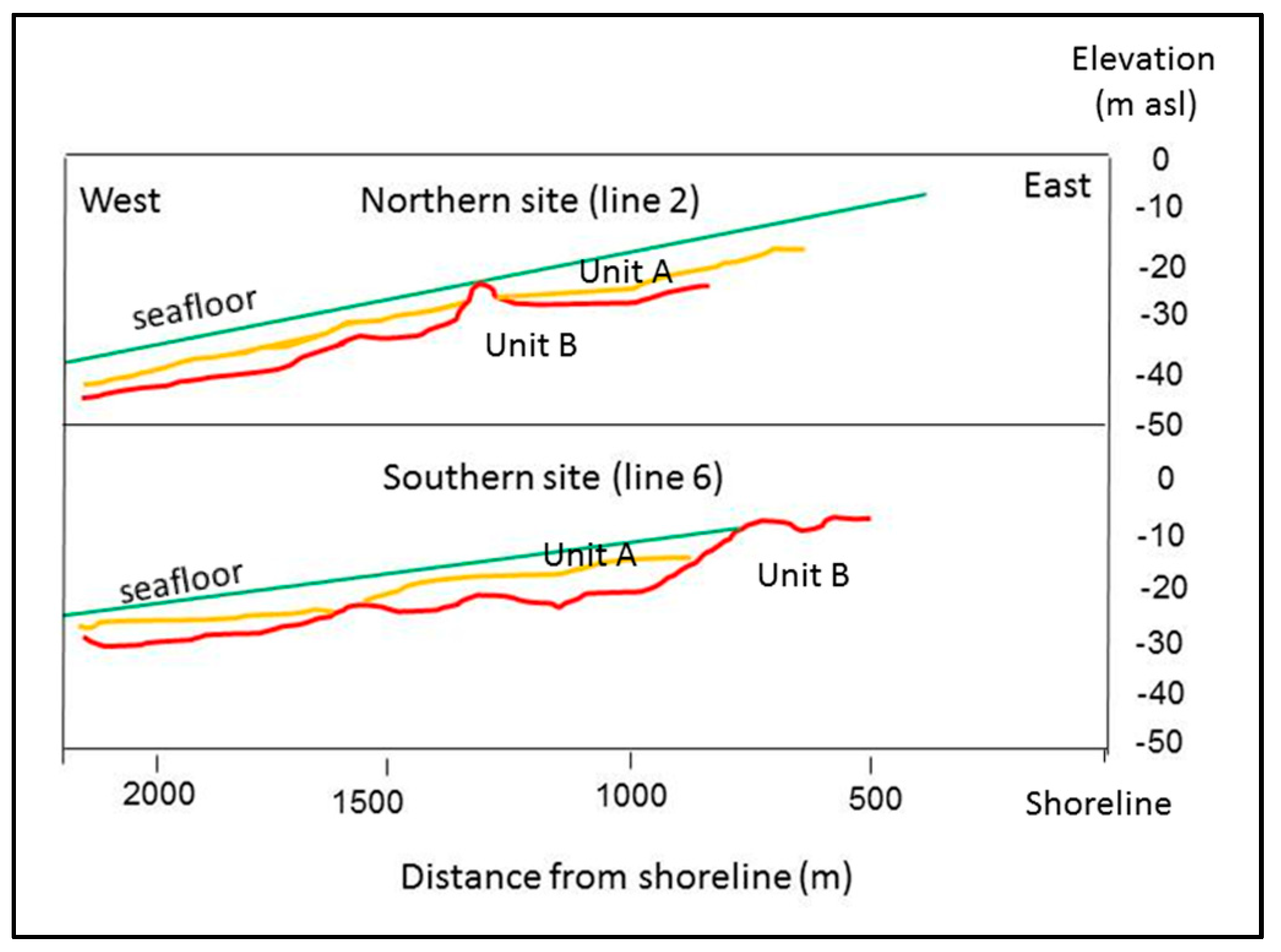
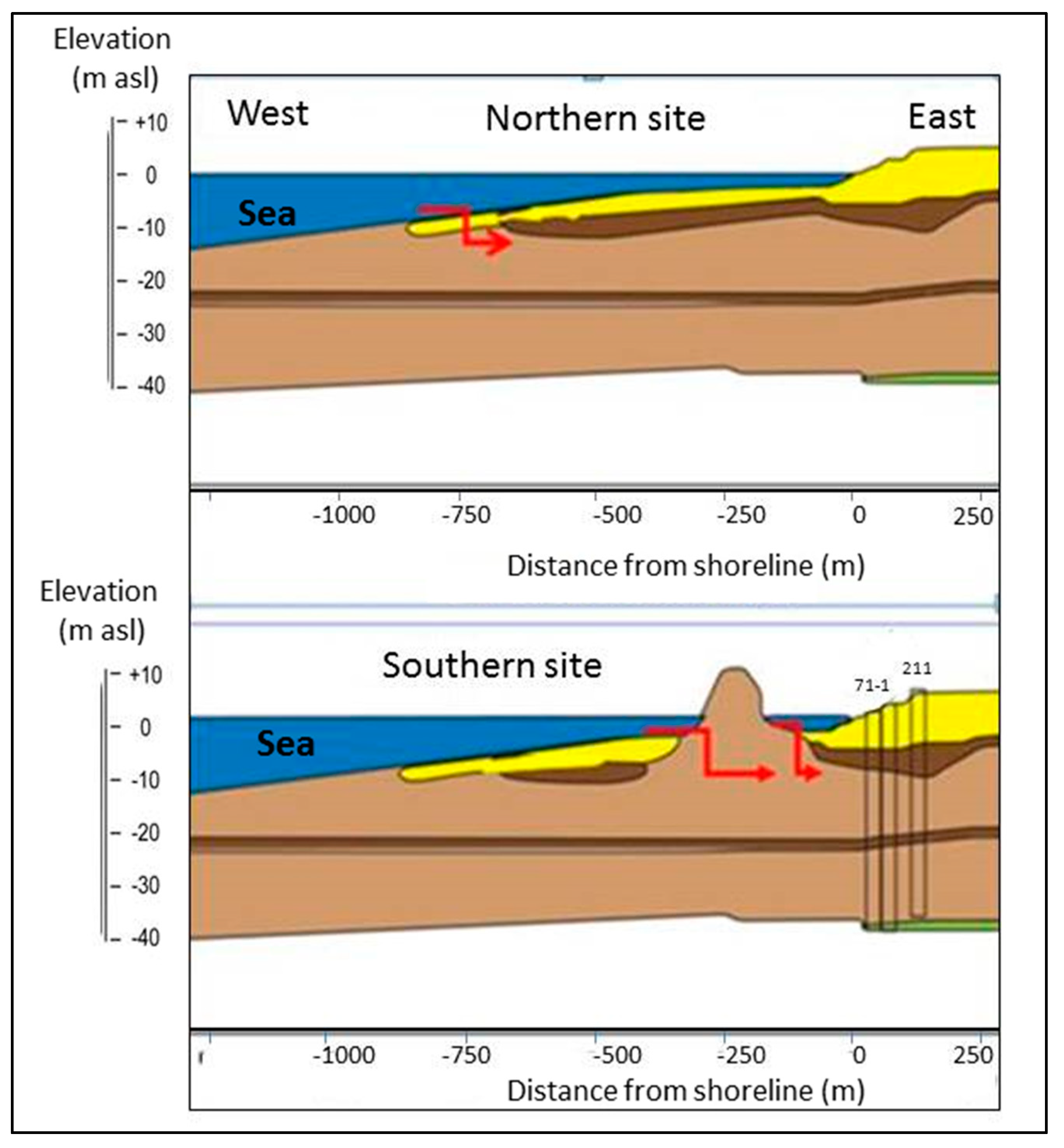
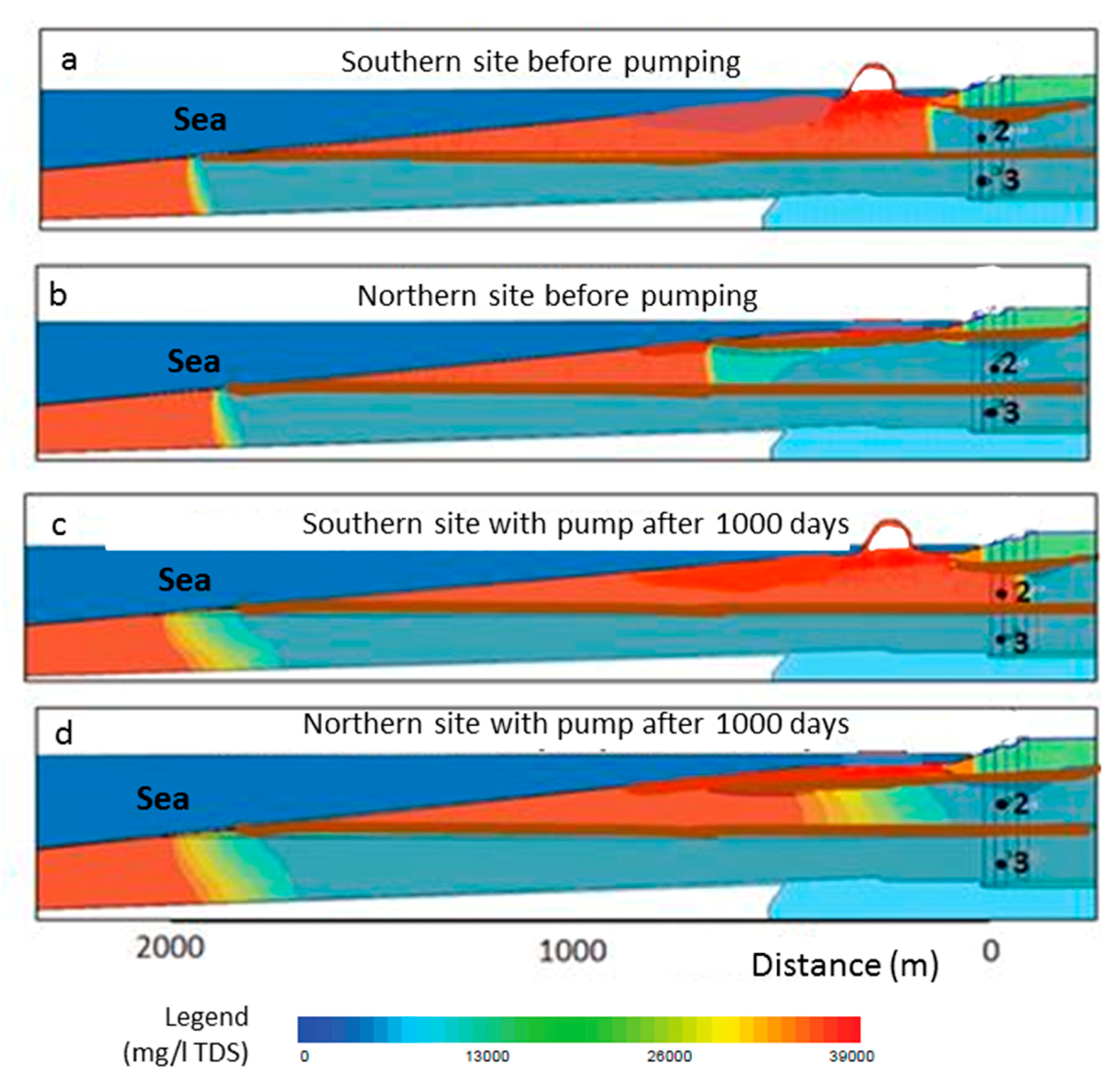



| Amplitude (cm) | Distance from Shoreline (m) | Aquifer Unit | Well Name |
|---|---|---|---|
| 21 | Sea | ||
| 0.5 | 70 | A—south | 71-3 |
| 13 | 70 | B—south | 71-2 |
| 9 | 70 | C—south | 71-1 |
| 7 | 70 | B—north | 73 |
| 4.5 | 300 | B | 2 |
| 3 | 500 | B—north | 1 |
| Rn | Source | Sample | |
|---|---|---|---|
| dpm/L | |||
| 841 | Calcareous sand stone | Units B + C | 71-1 |
| 628 | Calcareous sand stone | Units B + C | 71-2 |
| 5 | Fishpond | Pond | Fish pond |
| Unit A (South) | Unit B (South) | Unit C (South) | Unit B (North) | |
|---|---|---|---|---|
| 195 | 750 | 1200 | 780 | T (m2/day) |
| 30 | 68 | 109 | 71 | K (m/day) |
| 0.0001 | 0.0016 | S |
| Site | Level in the Eastern Border | Pump Condition | Well T5 | Well 71-2 | Well 71-1 |
|---|---|---|---|---|---|
| Late | Unit | Unit | |||
| Cretaceous | B | C | |||
| Southern site | H = +5 m | No pump | 4.6 | 1.2 | 2.8 |
| With pump | 4.2 | 0.6 | 1.4 | ||
| Southern site | H = +3 m | No pump | 2.8 | 0.8 | 1.9 |
| With pump | 2.4 | 0.3 | 0.8 | ||
| Northern site | H = +3 m | No pump | 2.8 | 1.8 | 2.2 |
| With pump | 2.3 | 0.3 | 0.8 |
| East Border Head (m) | Unit | Q (106 m3year−1 per 1 km) | Q (106 m3year−1 per 1 km) |
|---|---|---|---|
| without Pumping | with Pumping of 5 × 106 m3year−1 per 1 km | ||
| H = +5 | A | 0.4 | 0.3 |
| B | 1.2 | 2.6 | |
| C | 0.6 | 2.5 | |
| SUM | 2.2 | 5.4 | |
| H = +3 | A | 0.2 | 0.2 |
| B | 1.2 | 2.1 | |
| C | 0.3 | 2.3 | |
| SUM | 1.7 | 4.6 | |
| Eastern Border Head (m) | Unit | Q (106 m3year−1 per 1 km) | Q (106 m3year−1 per 1 km) |
|---|---|---|---|
| without Pumping | with Pumping of 5 × 106 m3year−1 per 1 km | ||
| H = +5 | A | 0.4 (1.8) | 0.3 (1.8) |
| B | 1.2 | −0.1 | |
| C | 0.6 | 0 | |
| SUM | 2.2 | 0.2 | |
| H = +3 | A | 0.2 (1.8) | 0.2 (1.8) |
| B | 1.2 | −0.7 | |
| C | 0.3 | −0.2 | |
| SUM | 1.7 | −0.7 | |
© 2018 by the authors. Licensee MDPI, Basel, Switzerland. This article is an open access article distributed under the terms and conditions of the Creative Commons Attribution (CC BY) license (http://creativecommons.org/licenses/by/4.0/).
Share and Cite
Tal, A.; Weinstein, Y.; Wollman, S.; Goldman, M.; Yechieli, Y. The Interrelations between a Multi-Layered Coastal Aquifer, a Surface Reservoir (Fish Ponds), and the Sea. Water 2018, 10, 1426. https://doi.org/10.3390/w10101426
Tal A, Weinstein Y, Wollman S, Goldman M, Yechieli Y. The Interrelations between a Multi-Layered Coastal Aquifer, a Surface Reservoir (Fish Ponds), and the Sea. Water. 2018; 10(10):1426. https://doi.org/10.3390/w10101426
Chicago/Turabian StyleTal, Adi, Yishai Weinstein, Stuart Wollman, Mark Goldman, and Yoseph Yechieli. 2018. "The Interrelations between a Multi-Layered Coastal Aquifer, a Surface Reservoir (Fish Ponds), and the Sea" Water 10, no. 10: 1426. https://doi.org/10.3390/w10101426
APA StyleTal, A., Weinstein, Y., Wollman, S., Goldman, M., & Yechieli, Y. (2018). The Interrelations between a Multi-Layered Coastal Aquifer, a Surface Reservoir (Fish Ponds), and the Sea. Water, 10(10), 1426. https://doi.org/10.3390/w10101426





